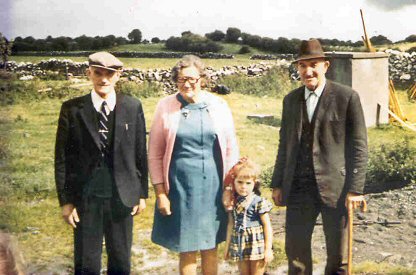John (Jack) Coleman was born to John and Mary Coleman of Turloughmore, The Neale, County Mayo, Ireland on the 25th day of February, 1906. Next day, he was baptised John Joseph Coleman in the Catholic Church of The Neale on the 26th day of February, 1906 by the famous Land League priest, Father John O'Malley.
He began his schooling at The Neale National School in 1911 but transferred to Gortjordan National School in 1917 when his family relocated to Cahermaculick, five miles from Turloughmore.
At the age of thirty, he migrated to England where he worked with horses in and around London and Epsom for a few years. It was here that he met Doris Watts who later in 1941 became his wife after they had moved to Grandbourgh which is located six miles south of Rugby. When not helping with the war effort, he worked on the land. Sadly, Doris passed away in 1942 shortly after the birth of their son, Patrick.
Shortly afterwards, the family moved to a farm just outside Dunchurch in Rugby where Jack maried Jessie Lovell in 1945. It was here that their sons John Harold and Ronald John and their daughter Linda Maureen were born. In 1952, the family moved to Dunchurch in Rugby where Jack and Jessie lived for the rest of their lives. Jack died in 1986 and Jessie a year later. Jack loved the outdoors and so worked most of his life on the land.?
|
|
Rugby for centuries was merely High Street, Sheep Street, North Street, and the Market Place. It only grew into an important settlement during the 19th century.
Rugby School, one of England's oldest and most prestigious public schools, rose to national prominence in the 18th century when during the headmastership of Dr Thomas Arnold it contributed to a radical change in Public School education in England.
The growing popularity of the school in the 18th and early 19th century led to an increase in population of the town as many parents preferred their sons to be able to go to a normal home life each night instead of having to endure poor boarding school conditions. Rugby School during this period was immortalised by Thomas Hughes in his semi-autobiographical novel ‘Tom Brown's Schooldays’.
The establishment of the engineering works in Rugby attracted many workers to the town and in the early decades of the 20th century the population grew rapidly and Rugby's built-up area spread fast in all directions. In 1901 the population of Rugby was 16,950; by the 1930s, it had reached 40,000.
Due to its expansion, Rugby became a municipal borough in 1932.
In the late 1930s, Frank Whittle developed the jet engine in Rugby, with his work taking place at the British Thomson-Houston works, and at Brownsover Hall.
Unlike nearby Coventry and Nuneaton, Rugby was highly fortunate to avoid German bombing during the Second World War. This is perhaps somewhat surprising given the town's strategic importance as a railway junction and engineering centre. A few stray bombs landed on Dunchurch and some meant for the English Electric works caused damage to housing at New Bilton, but no other significant bomb damage occurred in the area. According to local legend, a reason Rugby was not bombed substantially by the Germans during the war was that Unity Mitford, a close friend of Hitler was staying at Hillmorton.
From the 1950s, Rugby gained a substantial Afro-Caribbean community, and a sizable community from the Indian sub-continent, making Rugby a multi-cultural town
The Legend of William Webb Ellis
The roots of modern rugby can be traced to the Rugby School. In 1749, the boys' school moved from the town centre to a new 8 acre site on the edge of the town known as the Close, providing more space for the boys to exercise.
The football played there between 1749-1823 had few rules. Although touchlines had been introduced to demarcate the playing area, the game was still fairly hectic, with teams often consisting of around 200 boys. The ball could be handled, but running with the ball was not allowed; progress towards the opposition’s goal was made by kicking.
While there is some debate and legend surrounding the exact moment and individual responsible for the game’s inception, the story of William Webb Ellis is perhaps the most enduring. According to legend, in autumn 1823, a young William Webb Ellis disregarded the established rules of football and, during a game on the Close, picked up the ball and ran with it.
According to the rules of the day, the opposing team could only advance to the spot where the ball had been caught, and Ellis should have moved backwards to give himself enough room to either kick the ball up the field or place it for a kick at goal. Instead, Ellis’ impulsive act is said to have laid the foundation for the game of rugby as we know it today.
While the veracity of this tale is debated, the symbolism of Webb Ellis’s actions has persisted, and he remains an iconic figure in the sport, with the Rugby World Cup trophy named after him.
Back to Family Centres - Forward to Dunchurch
 Clan Coleman
Clan Coleman
